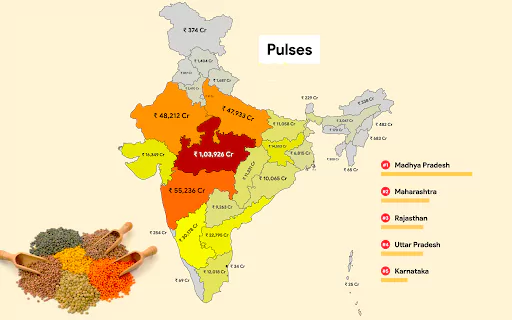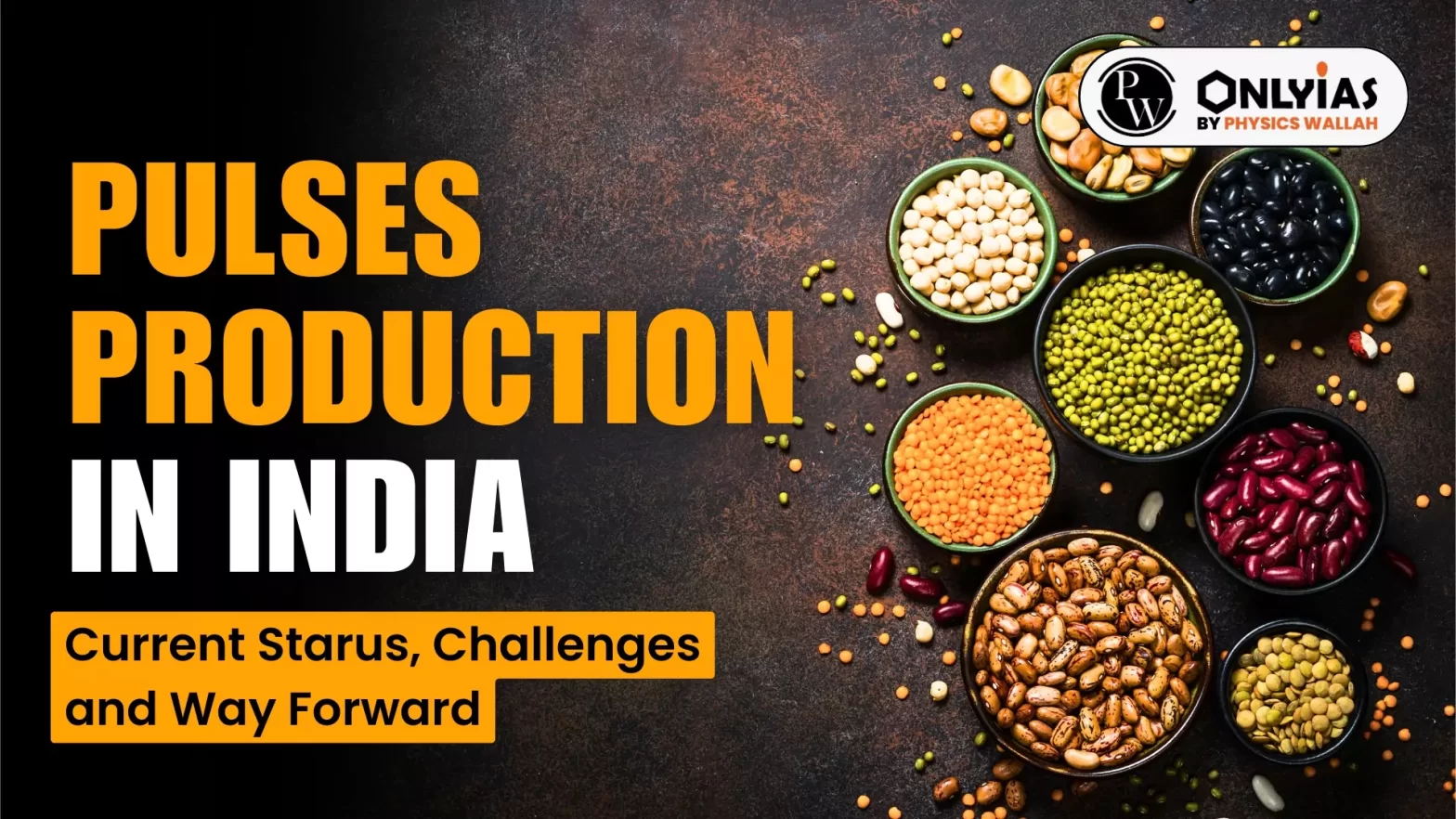Context
India has been facing a problem of persistent shortage in pulses production.
Enroll now for UPSC Online Course
Pulses Production in India: Current Data
- Decline in Crop Output: According to Department of Agriculture and Farmers’ Welfare, production has witnessed a significant fall in output during the 2023-24 crop year to about 234 lakh tonnes from around 260 lakh tonnes in 2022-23 and 273 lakh tonnes in 2021-22.
- Rise in Pulses inflation: As a result, inflation in the pulses and products’ group has gained momentum, accelerating to over 20 per cent in December 2023 from about 13 per cent in August 2023.

Pulses Map of India
Analysis of Pulses Production in India and Pulses Inflation Trends
- Moderation of Inflation Rates: The Prices of Pulses moderated slightly to about 17 per cent in March 2024 with augmented supplies through imports, fresh market arrivals and imposition of stock limits.
- Decline in Cultivation of Major Pulses: All the major pulses witnessed a drop in cultivation .
- Moong (green gram) registered a steep fall of over 40 per cent in acreage and about 60 per cent in output.
- Urad (black gram) with around 20 per cent fall in acreage and output in 2023-24 compared to that in the previous year primarily due to deficit rainfall in major producing States.
- Acreage under chana and tur witnessed a fall of 2.6 per cent and 0.6 per cent, respectively, their output remained nearly the same as that in the previous year.
- Disparity in Price Trends: The rise in prices of tur has been much steeper, at 30-40 per cent, than of moong and urad, at 10-14 per cent, during the past six months.
- Impact on Accessibility of Protein Sources: Any significant rise in the prices of pulses affects the poor the most, depriving them of a balanced diet.
- Persistent Lag in Meeting Demand: Unlike major cereals, the domestic production of pulses – despite a significant increase during the past decade to about 234 lakh tonnes in 2023-24 from about 171 lakh tonnes in 2014-15 – continues to lag demand.
- Increasing Reliance on Imports: India has remained dependent on pulses imports averaging 25 lakh tonnes per annum during the last five years to meet domestic consumption demand.
- However, with the drastic reduction in domestic output, the imports of pulses are expected to have risen steeply in 2023-24.
- Commerce Ministry data show aggregate imports of pulses increased by about 60 per cent to 32.5 lakh tonnes during April-January 2023-24 from about 20.3 lakh tonnes in the corresponding period of last year.
Challenges Associated with Imports of Pulses
- Challenges in Short-Term Pulse Imports: Unlike oilseeds, the scope for augmenting supplies of pulses through imports in the short-term is limited as India is the largest producer as well as consumer of pulses in the world.
- Traditional Import Sources: Myanmar has been the traditional source of imports for tur, moong and urad, while for peas it is Canada and Australia.
- Emerging Import Origins: However, some of the African countries, including Tanzania, Mozambique, Malawi and Kenya, have become sources of imports in recent years.
- Price Dynamics in Exporting Countries: Further, the prices in these exporting countries can be influenced by the shortages in India and may become much costlier than the domestically produced pulses.
- Decline in Per Capita Availability of Pulses: The per capita availability of pulses has declined steadily from about 25 kg in 1961 to 16 kg in 2021 due to sluggish growth in production since the 1960s.
- Shift in Cropping Patterns: There has been a significant shift in cropping pattern from cereal-pulse to cereal-cereal, particularly in irrigated areas across the country.
- Disparity in Irrigated Area: The extent of area irrigated for sugarcane, wheat and rice stood at 96 per cent, 95 per cent and 65 per cent, respectively, while that of pulses is only about 23 per cent, according to the Department of Economics and Statistics, Ministry of Agriculture.
- As a result, the yields and output of pulses have remained low.
Way Forward to Increase Pulses Production in India
- Significance of Pulses in Indian Diet: Pulses are an indispensable part of the Indian food basket both among the rich and the poor alike.
- Impact of Production Deficit on Affordability: But the persistent deficit in domestic production and the consequent rise in prices are making them unaffordable for the poor.
- Measures to Address Supply Deficit: While a number of steps have been taken by the government to augment open market supplies in the short-term with imports and limitations on stock-holding, it is imperative to raise production in the long-run.
- Promotion of Pulses Cultivation: Immediate steps must be taken to promote pulses cultivation in fertile and irrigated areas, providing input incentives and assured remunerative prices.
- Benefits of Pulses Cultivation for Sustainable Agriculture: Further, cultivation of pulses can promote sustainable agriculture by enriching soil fertility and conserving water, with minimal irrigation and short crop duration.
- Awareness Creation in Agricultural Extension Systems: Towards this, the agricultural extension system needs to create awareness among the farmers regarding the positive externalities of pulses cultivation.
Enroll now for UPSC Online Classes
Conclusion
The Government of India should Implement comprehensive support programs for pulse farmers, including access to credit, insurance coverage, and extension services. Strengthening farmer producer organizations (FPOs) to empower farmers collectively and enhance their bargaining power in the market.
Also Read: Global Pulses Conference 2024: Key Highlights
| Prelims PYQ (20):
Among the agricultural commodities imported by India, which one of the following accounts for the highest imports in terms of value in the last five years?
(a) Spices
(b) Fresh fruits
(c) Pulses
(d) Vegetable oils
Ans: (d) |
![]() 17 Apr 2024
17 Apr 2024


